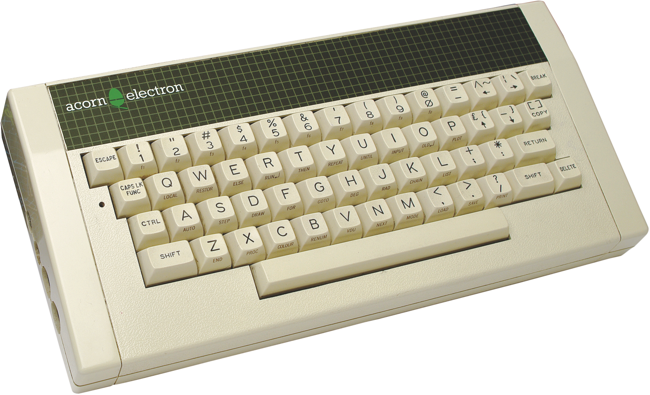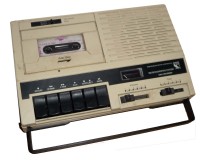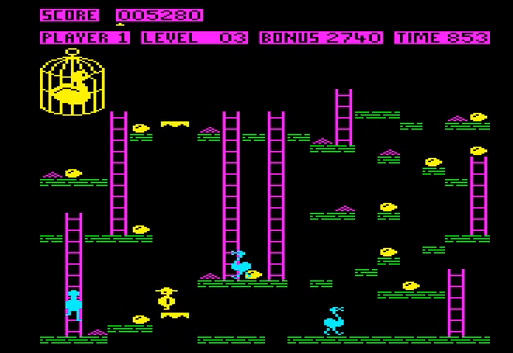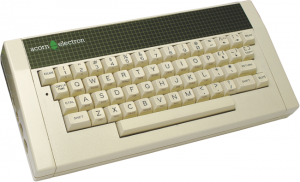
The Acorn Electron was the very first computer I ever owned, while all my friends were looking at Sinclair’s offerings I was always more drawn to the BBC range of computers including the model B which at the time was too expensive to have as a home computer for me. What the Acorn Electron offered was a computer from the BBC family at half the size and a fraction of the cost coming in at £199 which back in 1983 when it was released was actually a lot of money considering the price of computers laptops and games consoles like th PS4 and Xbox 1 cost now in 2016.
The model was launched in the August 1983 and this was a must have Xmas present a reported 300,000 orders were placed in the run up to the Christmas and I was on the list, we are going back a long way now but I remember the computer shop at the time and going in to see if it had arrived only to be told it hadn’t arrived. (no checking online or waiting for a text message in 1983). I believe later because of problems in the ULA the main part of the machine that only one in ten they produced actually worked and therefore only 30,000 ever made the shops and were sold in time for Christmas.
Luckily for me I was one of the luck 30,000 and my Christmas was complete that year. I never thought 33 years later I would be writing about this little computer which I still own and is hidden in my loft somewhere (I will update this post with a picture next time I come across it).
Games
 Loading the games was nothing but frustrating, the games came on a cassette and this was a separate player linked to your computer, you had to press play and adjust the volume to just the right setting to make sure the computer started loading the software. The screen would then show this sort of psychedelic display of blocks of colours so you knew it was loading, however after what seemed like 30 mins of the screeching noise sometimes you found the game had not loaded and you would have to repeat the whole process this time with the volume slightly adjusted to make sure this time it worked. (I sound like an old dad when I say kids don’t know they are born the speed games load now and they still moan these are slow, if only they knew !!)
Loading the games was nothing but frustrating, the games came on a cassette and this was a separate player linked to your computer, you had to press play and adjust the volume to just the right setting to make sure the computer started loading the software. The screen would then show this sort of psychedelic display of blocks of colours so you knew it was loading, however after what seemed like 30 mins of the screeching noise sometimes you found the game had not loaded and you would have to repeat the whole process this time with the volume slightly adjusted to make sure this time it worked. (I sound like an old dad when I say kids don’t know they are born the speed games load now and they still moan these are slow, if only they knew !!)
I was very much trying to programme the computer in its basic language this is where I think my love of all things gadget and computers came from, however I very much remember the game called Chuckie Egg, the idea was to collect the eggs climbing up levels without being caught by the birds and I think to win you had to reach the main bird in the cage, controls were primitive sided to side up the ladder and down and a jump function.

Specification
Processor: The Acorn PC typically used a Motorola 68000 series processor, which was a 16/32-bit microprocessor running at various clock speeds.
Memory: The memory configuration varied depending on the model and configuration, but the Acorn PC usually had options for both RAM and ROM memory. RAM capacity could range from a few kilobytes to several megabytes.
Operating System: The Acorn PC initially ran the Arthur operating system, which was later developed into RISC OS. These operating systems were designed to work with Acorn’s ARM architecture-based processors and provided a graphical user interface and multitasking capabilities.
Display: The Acorn PC supported various display resolutions and color depths, typically ranging from monochrome to 256 colors. The exact specifications could vary depending on the graphics hardware and expansion cards used.
Storage: The Acorn PC could be equipped with floppy disk drives for data storage and program loading. Later models also supported hard drives and other storage options.
Expansion: The Acorn PC featured expansion slots for adding additional hardware components such as graphics cards, networking cards, and other peripherals.
Input/Output: The system had standard ports for connecting peripherals, including serial ports, parallel ports, and joystick/mouse ports.
Keyboard and Mouse: The Acorn PC used a standard keyboard layout and often included a mouse for interacting with the graphical user interface.
Sound: The sound capabilities of the Acorn PC varied depending on the model and expansion cards. Some models featured basic sound generation capabilities, while others could support more advanced sound hardware.
Software Compatibility: The Acorn PC primarily ran software developed for the RISC OS operating system. It also had some compatibility with software written for the earlier BBC Microcomputer System.
Conclusion
As I actually owned a Acorn Electron and this was my first computer it will always be my favourite from the early home computers of the 1980’s although my friends and family didn’t share my enthusiasm and went onto to buy other machines from this time inclusing the ZX Spectrum, the Dragon 32 an Commador 64 which I will all cover in detail in this journey through the history of the now Retro Computer.


